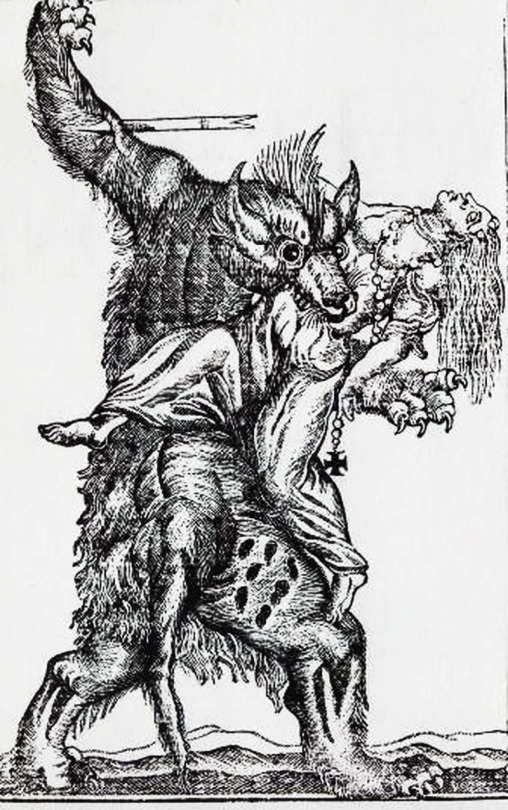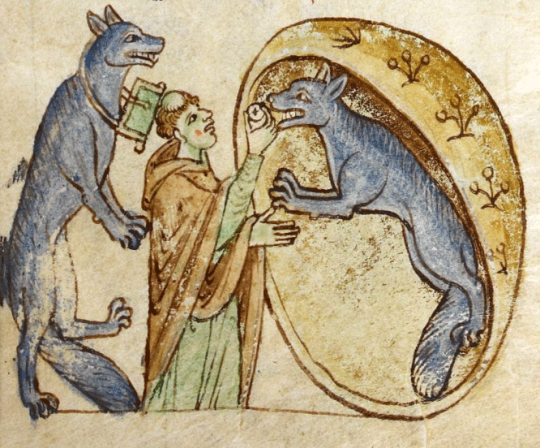Physical Appearance
This is a fun one. It’s also a big one. The question is – what do werewolves look like, anyway?
Depending on who you ask (and when you ask, and WHERE you ask), you’ll get a lot of different answers.
Werewolves come in three major types, in terms of appearance…
Wolf-Men

Yep, you got it, we’re talking the traditional wolf-man look! That was a thing in legends, too, not just Hollywood. Where, you ask? Various places – but probably especially Germany and France (both of which were overflowing with werewolves, anyway).
Some werewolves turned into basically just hairy guys with big, sharp teeth and long, sharp claws. Did they always have a nasty demeanor and eat kids like the one in the woodcut? No, not really. Were some of them berserkers? Well – yeah, probably!
Man-Wolves

Believe it or not, there’s a gracious plenty of folkloric basis for the concept of a “man-wolf” (as they are sometimes called). That is to say, a werewolf with the head, fur, tail, and legs of a wolf, but the torso, arms, and hands of a man. That means, of course, they still come equipped with claws.
These appeared almost everywhere around the world, much like the last appearance category. But they were probably still most common in regions of Europe, especially Germany, France, Italy, and Eastern Europe.
You’ll see variations of these around in media today, too, of course. And plenty of them are great.
Granted, they occasionally lack tails (for some reason…) and often – these days – have absurd-looking ears for no apparent reason, and/or lack fur, but that doesn’t always detract from how awesome they are. You know… as long as they still look remotely like wolves, which I can’t say that all of them do.
Wolves

That’s right – just wolves. Usually very, very big wolves (”impossibly large,” “the largest wolf ever seen,” etc., often described as horse-size or sometimes larger), but sometimes just normal-sized wolves, too.
This was common just about everywhere. It can’t really be pinpointed to any particular regions – or even continents.
I’ve had a lot of people tell me, “The werewolves in Twilight are so stupid, they just turn into wolves!”
Sorry, everyone, but any opinions and nitpicky details regarding the lore of Twilight and its werewolves (and not-werewolves; remember, Meyer later retconned that Jacob and his pack aren’t even technically werewolves) aside, werewolves have turned into just wolves perhaps more often than any other form they take.
Simple post for such a big topic? Maybe. But I’m going to be covering a lot of these legends individually, so you’ll get to hear what the werewolves look like in each. Or, if you have any specific questions in regard to this stuff, just shoot me an ask!
I can say, though, that the order of how often these appearance archetypes showed up in folklore would be ranked like this:
- Wolves
- Man-Wolves
- Wolf-Men (by far the least)
Any other werewolf appearances are just pop culture things again. Oh, and yes – werewolves in folklore always had fur (lots of fur!), and claws and fangs, and definitely tails.
Vocalizations include wolf vocalizations, often plus some. Werewolves, of course, also howl, which pop culture werewolves today often seem to have something against doing (absurdly, as the howl is the signature and truly unique sound of the wolf). And for the record, werewolves do not bark, so please stop those jokes before you get mauled.
(Wolves don’t bark, either. When they do bark, it sounds very different from domestic dog barks, very short and rough, never continuously, and is almost always combined with and/or comparable to another sound. Wolves use more complex communication than barking; they howl, grunt, huff, etc., instead. So, video games, you can stop making wolves bark at literally everything.)
Pop quiz!
How do you tell a werewolf from a witch with a wolf disguise?
Answer: werewolves have tails. Witches do not. Just ask the Malleus Maleficarum. Hold your tail with pride, werewolves – it means you aren’t a witch! (and if you don’t have one I guess you aren’t a werewolf, sorry)